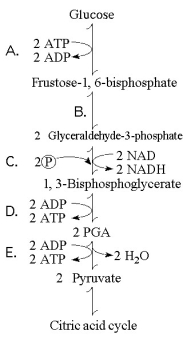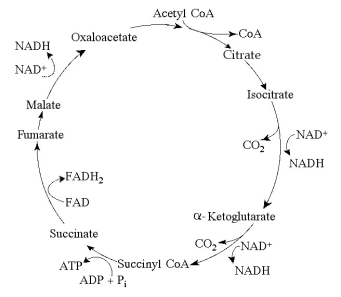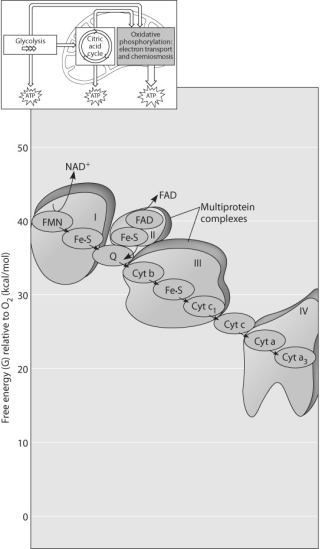A) ATP synthesis and heat generation will both increase.
B) ATP synthesis will increase, and heat generation will decrease.
C) ATP synthesis will decrease, and heat generation will increase.
D) ATP synthesis and heat generation will both decrease.
E) ATP synthesis and heat generation will stay the same.
Correct Answer

verified
Correct Answer
verified
Multiple Choice
It is possible to prepare vesicles from portions of the inner mitochondrial membrane. Which one of the following processes could still be carried on by this isolated inner membrane?
A) the citric acid cycle
B) oxidative phosphorylation
C) glycolysis and fermentation
D) reduction of NAD⁺
E) both the citric acid cycle and oxidative phosphorylation
Correct Answer

verified
Correct Answer
verified
Multiple Choice
Figure 9.1 illustrates some of the steps (reactions) of glycolysis in their proper sequence. Each step is lettered. Use these letters to answer the questions.
 Figure 9.1
-In which step in Figure 9.1 is an inorganic phosphate added to the reactant?
Figure 9.1
-In which step in Figure 9.1 is an inorganic phosphate added to the reactant?
A) A
B) B
C) C
D) D
E) E
Correct Answer

verified
Correct Answer
verified
Multiple Choice
When electrons flow along the electron transport chains of mitochondria, which of the following changes occurs?
A) The pH of the matrix increases.
B) ATP synthase pumps protons by active transport.
C) The electrons gain free energy.
D) The cytochromes phosphorylate ADP to form ATP.
E) NAD⁺ is oxidized.
Correct Answer

verified
Correct Answer
verified
Multiple Choice
The final electron acceptor of the electron transport chain that functions in aerobic oxidative phosphorylation is
A) oxygen.
B) water.
C) NAD⁺.
D) pyruvate.
E) ADP.
Correct Answer

verified
Correct Answer
verified
Multiple Choice
Where are the proteins of the electron transport chain located?
A) cytosol
B) mitochondrial outer membrane
C) mitochondrial inner membrane
D) mitochondrial intermembrane space
E) mitochondrial matrix
Correct Answer

verified
Correct Answer
verified
Multiple Choice
 Figure 9.2 The citric acid cycle.
-Starting with one molecule of isocitrate and ending with fumarate, how many ATP molecules can be made through substrate-level phosphorylation (see Figure 9.2) ?
Figure 9.2 The citric acid cycle.
-Starting with one molecule of isocitrate and ending with fumarate, how many ATP molecules can be made through substrate-level phosphorylation (see Figure 9.2) ?
A) 1
B) 2
C) 11
D) 12
E) 24
Correct Answer

verified
Correct Answer
verified
Multiple Choice
The ATP made during glycolysis is generated by
A) substrate-level phosphorylation.
B) electron transport.
C) photophosphorylation.
D) chemiosmosis.
E) oxidation of NADH to NAD⁺.
Correct Answer

verified
Correct Answer
verified
Multiple Choice
The synthesis of ATP by oxidative phosphorylation, using the energy released by movement of protons across the membrane down their electrochemical gradient, is an example of
A) active transport.
B) an endergonic reaction coupled to an exergonic reaction.
C) a reaction with a positive ΔG .
D) osmosis.
E) allosteric regulation.
Correct Answer

verified
Correct Answer
verified
Multiple Choice
The transport of pyruvate into mitochondria depends on the proton-motive force across the inner mitochondrial membrane. How does pyruvate enter the mitochondrion?
A) active transport
B) diffusion
C) facilitated diffusion
D) through a channel
E) through a pore
Correct Answer

verified
Correct Answer
verified
Multiple Choice
If a cell is able to synthesize 30 ATP molecules for each molecule of glucose completely oxidized by carbon dioxide and water, how many ATP molecules can the cell synthesize for each molecule of pyruvate oxidized to carbon dioxide and water?
A) 0
B) 1
C) 12
D) 14
E) 15
Correct Answer

verified
Correct Answer
verified
Multiple Choice
A young animal has never had much energy. He is brought to a veterinarian for help and is sent to the animal hospital for some tests. There they discover his mitochondria can use only fatty acids and amino acids for respiration, and his cells produce more lactate than normal. Of the following, which is the best explanation of his condition?
A) His mitochondria lack the transport protein that moves pyruvate across the outer mitochondrial membrane.
B) His cells cannot move NADH from glycolysis into the mitochondria.
C) His cells contain something that inhibits oxygen use in his mitochondria.
D) His cells lack the enzyme in glycolysis that forms pyruvate.
E) His cells have a defective electron transport chain, so glucose goes to lactate instead of to acetyl CoA.
Correct Answer

verified
Correct Answer
verified
Multiple Choice
One function of both alcohol fermentation and lactic acid fermentation is to
A) reduce NAD⁺ to NADH.
B) reduce FAD⁺ to FADH₂.
C) oxidize NADH to NAD⁺.
D) reduce FADH₂ to FAD⁺.
E) do none of the above.
Correct Answer

verified
Correct Answer
verified
Multiple Choice
Why is glycolysis considered to be one of the first metabolic pathways to have evolved?
A) It produces much less ATP than does oxidative phosphorylation.
B) It does not involve organelles or specialized structures, does not require oxygen, and is present in most organisms.
C) It is found in prokaryotic cells but not in eukaryotic cells.
D) It relies on chemiosmosis, which is a metabolic mechanism present only in the first cells' prokaryotic cells.
E) It requires the presence of membrane-enclosed cell organelles found only in eukaryotic cells.
Correct Answer

verified
Correct Answer
verified
Multiple Choice
A mutation in yeast makes it unable to convert pyruvate to ethanol. How will this mutation affect these yeast cells?
A) The mutant yeast will be unable to grow anaerobically.
B) The mutant yeast will grow anaerobically only when given glucose.
C) The mutant yeast will be unable to metabolize glucose.
D) The mutant yeast will die because they cannot regenerate NAD⁺ from NAD.
E) The mutant yeast will metabolize only fatty acids.
Correct Answer

verified
Correct Answer
verified
Multiple Choice
Which process in eukaryotic cells will proceed normally whether oxygen (O₂) is present or absent?
A) electron transport
B) glycolysis
C) the citric acid cycle
D) oxidative phosphorylation
E) chemiosmosis
Correct Answer

verified
Correct Answer
verified
Multiple Choice
Which of the following normally occurs regardless of whether or not oxygen (O₂) is present?
A) glycolysis
B) fermentation
C) oxidation of pyruvate to acetyl CoA
D) citric acid cycle
E) oxidative phosphorylation (chemiosmosis)
Correct Answer

verified
Correct Answer
verified
Multiple Choice
 Figure 9.3
-What happens at the end of the chain in Figure 9.3?
Figure 9.3
-What happens at the end of the chain in Figure 9.3?
A) 2 electrons combine with a proton and a molecule of NAD⁺.
B) 2 electrons combine with a molecule of oxygen and two hydrogen atoms.
C) 4 electrons combine with a molecule of oxygen and 4 protons.
D) 4 electrons combine with four hydrogen and two oxygen atoms.
E) 1 electron combines with a molecule of oxygen and a hydrogen atom.
Correct Answer

verified
Correct Answer
verified
Multiple Choice
In glycolysis, for each molecule of glucose oxidized to pyruvate
A) two molecules of ATP are used and two molecules of ATP are produced.
B) two molecules of ATP are used and four molecules of ATP are produced.
C) four molecules of ATP are used and two molecules of ATP are produced.
D) two molecules of ATP are used and six molecules of ATP are produced.
E) six molecules of ATP are used and six molecules of ATP are produced.
Correct Answer

verified
Correct Answer
verified
Multiple Choice
Substrate-level phosphorylation accounts for approximately what percentage of the ATP formed by the reactions of glycolysis?
A) 0%
B) 2%
C) 10%
D) 38%
E) 100%
Correct Answer

verified
Correct Answer
verified
Showing 61 - 80 of 107
Related Exams